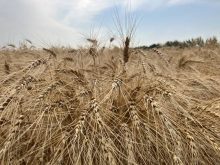Chicago | Reuters—Chicago wheat futures eased on Tuesday as geopolitical tensions between Russia and Ukraine faded into the background and brisk exports of Black Sea wheat continued to pose tough competition to U.S. wheat exports, traders said.
Soy futures ticked up as traders monitor heat and dryness in Brazil that could pose a threat to soybean seeding in the world’s top soybean exporter.
Corn futures ticked up after a day of choppy trading as the U.S. ramps up what is expected to be a bumper harvest and farmers took advantage of relatively higher prices to sell old-crop corn.
Read Also

Record large Canadian wheat and canola crops: Statistics Canada
Canadian wheat and canola production in 2025/26 (Aug/Jul) surpassed early expectations to hit new record highs, according to updated survey-based estimates from Statistics Canada released Dec. 4.
“It’s not a victory for farmers, but they’re getting the last pieces of the crop out while it’s sitting at higher levels,” said Joe Davis, a trader at Futures International.
The most active wheat contract on the Chicago Board of Trade (CBOT) Wv1 settled down 2-3/4 cents to $5.75-3/4 per bushel, while CBOT soybeans Sv1 settled up 1-1/2 cents to $10.06 per bushel. Corn Cv1 settled up 1-3/4 cents to $4.12-1/2 per bushel.
The U.S. Department of Agriculture on Monday rated 65 per cent of the U.S. corn crop as “good-to-excellent,” above analysts’ estimates, and 64 per cent of the soybean crop as “good-to-excellent,” matching expectations.
The USDA said the U.S. corn harvest was nine per cent complete by Sunday and the soybean harvest was six per cent complete, both 3 percentage points ahead of their five-year averages.
The condition ratings are the highest for this time of year since 2018, underscoring expectations for large harvests. Brazil’s government forecast a soybean crop that would be 12.8 per cent higher than last year, though a drought could threaten soy seeding and kept a bottom on soy prices.
A missile attack on a grain vessel in the Black Sea last week that Ukraine blamed on Moscow as well as dryness in key wheat-growing areas have been priced into the wheat market and added little support to futures on Tuesday, traders said.














